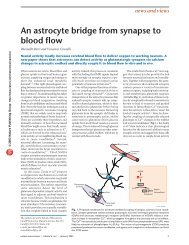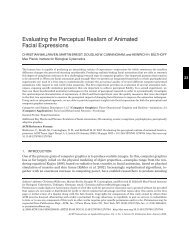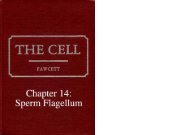Chapter 12: Centrioles
Chapter 12: Centrioles
Chapter 12: Centrioles
You also want an ePaper? Increase the reach of your titles
YUMPU automatically turns print PDFs into web optimized ePapers that Google loves.
CENTRIOLES<br />
In ciliogenesis, newly formed single centrioles, serving as basal bodies, are<br />
arranged in rows and oriented perpendicular to the cell surface. The end that is adjacent<br />
to the membrane functions as a site of nucleation for microtubule protein which<br />
polymerizes on subunits a and b of the triplets to form the nine doublet microtubules of<br />
the axoneme. The centrioles arrive at the cell apex at different times and the<br />
polymerization of tubulin evidently begins as soon as the end of the organelle is<br />
juxtaposed to the membrane. Thus in the accompanying micrograph four developing<br />
cilia are seen in successive stages of growth.<br />
Flagella usually arise from one member of a pair of centrioles positioned at right<br />
angles. The axoneme grows out from the one perpendicular to the membrane. The<br />
lower figure on the facing page shows early stages in formation of a sperm flagellum.<br />
The differing lengths of the distal centrioles illustrated is attributable to the fact that the<br />
micrographs are not all from the same species. In one example (B) the second centriole<br />
is out of the plane of section. In sperm tail development the centrioles are involved in<br />
organizing other components in addition to the axoneme. In the most advanced stage<br />
shown (D), both centrioles are sectioned longitudinally. The thin line above the<br />
proximal centriole (*) is the anlage of the capitulum which will later articulate with the<br />
implantation fossa of the sperm nucleus. The periodic densities in the bracket (**)<br />
represent an early stage in assembly of the cross-striated columns of the connecting<br />
piece. The adjunct has begun to develop at the other end of the proximal centriole (at<br />
arrow). The centrioles thus appear to be involved in the organization of four distinct<br />
structures - axoneme, capitulum, centriolar adjunct, and connecting piece.<br />
Figure 311.<br />
Ciliated cell of the mammalian oviduct (Micrograph courtesy of Everett Anderson.)<br />
Figure 3<strong>12</strong>. Successive stages of flagellum formation in spermatids.<br />
Figure 3 11, upper<br />
Figure 3 <strong>12</strong>, h er<br />
567









